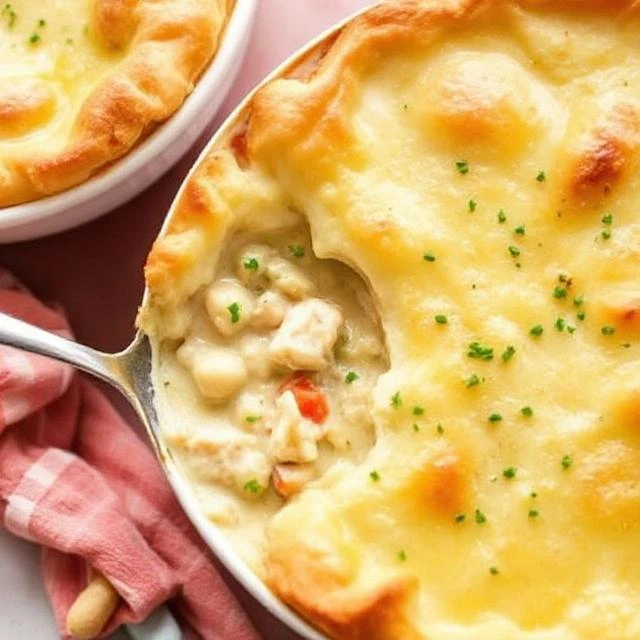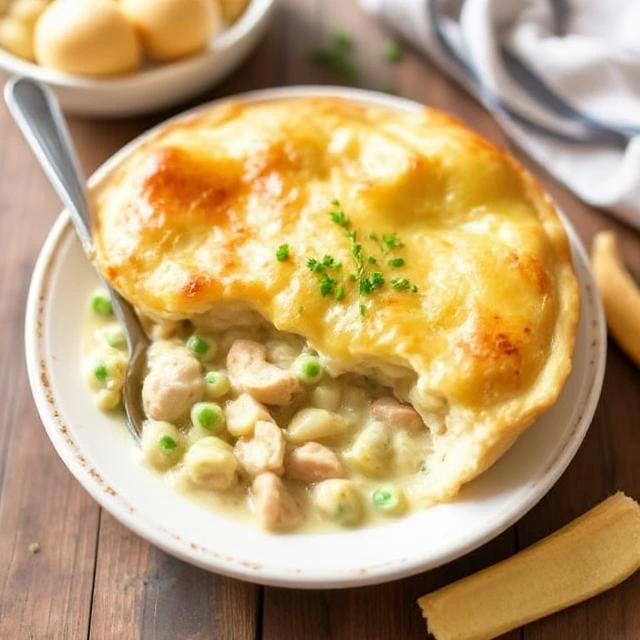INTRODUCTION
Chicken pot pie stands as a timeless comfort food, offering a harmonious blend of tender chicken, vibrant vegetables, and a luscious, creamy sauce, all encased within a flaky, golden crust. This dish not only satisfies the palate but also evokes a sense of warmth and homeliness. In this comprehensive guide, we’ll explore the nuances of crafting the ultimate chicken pot pie, ensuring it’s easy to prepare, irresistibly creamy, and utterly delicious.
A Brief History of Chicken Pot Pie
The origins of chicken pot pie trace back to ancient civilizations, where meat pies were a staple. The Greeks and Romans baked meats encased in pastry, primarily as a method of preservation. Over time, this culinary practice evolved, with each culture adding its unique touch. In America, chicken pot pie gained prominence as a hearty meal, especially in regions with harsh winters, providing both sustenance and comfort.

Essential Ingredients
Creating a delectable chicken pot pie requires attention to the quality and selection of ingredients. Here’s a breakdown:
- Chicken: Opt for boneless, skinless chicken breasts or thighs. Using pre-cooked rotisserie chicken can expedite the process without compromising flavor.
- Vegetables: A classic mix includes onions, carrots, peas, and celery. However, feel free to incorporate other favorites like corn, green beans, or mushrooms.
- Creamy Sauce: The richness comes from a roux-based sauce, combining butter, flour, chicken broth, and milk or cream. For added depth, consider a splash of white wine or a dollop of sour cream.
- Herbs and Seasonings: Fresh thyme, parsley, salt, and pepper are traditional. Adjust to taste, perhaps adding rosemary or sage for a unique twist.
- Pie Crust: A buttery, flaky crust is essential. While homemade crusts offer superior flavor, store-bought versions can be convenient and time-saving.

Step-by-Step Preparation
1. Preparing the Filling
Sautéing the Aromatics: In a large skillet, melt butter over medium heat. Add finely chopped onions, carrots, and celery. Sauté until the onions are translucent and the vegetables begin to soften, approximately 5-7 minutes.
Incorporating the Chicken: Add diced chicken to the skillet. If using raw chicken, cook until it’s no longer pink. For pre-cooked chicken, simply heat through.
Creating the Sauce: Sprinkle flour over the chicken and vegetable mixture, stirring continuously to form a roux. Cook for about 2 minutes to eliminate the raw flour taste. Gradually pour in chicken broth, stirring to combine. Add milk or cream, bringing the mixture to a gentle simmer until it thickens. Season with salt, pepper, and herbs.
Adding Vegetables: Stir in peas and any other quick-cooking vegetables. Remove from heat and let the filling cool slightly.
2. Assembling the Pie
Preparing the Crust: Roll out the pie dough on a floured surface. Line a pie dish with the bottom crust, allowing excess to hang over the edges.
Filling the Pie: Pour the cooled chicken and vegetable mixture into the prepared crust.
Topping with the Upper Crust: Roll out the second piece of dough and place it over the filling. Trim any excess dough, and crimp the edges to seal. Cut slits or create decorative vents on top to allow steam to escape.
3. Baking
Preheat the oven to 400°F (200°C). Brush the top crust with an egg wash for a glossy finish. Place the pie on a baking sheet to catch any drips and bake for 30-35 minutes, or until the crust is golden brown and the filling is bubbly. Let the pie rest for 10 minutes before serving to set the filling.
Tips for Success
- Preventing a Soggy Bottom Crust: To avoid a soggy crust, consider pre-baking (blind baking) the bottom crust for 10 minutes before adding the filling. Additionally, ensure the filling is cooled before assembling the pie.
- Enhancing Flavor: Incorporate a splash of white wine into the sauce or a teaspoon of Dijon mustard for added depth. Fresh herbs can elevate the dish, providing a burst of flavor.
- Time-Saving Shortcuts: Utilize store-bought rotisserie chicken and pre-made pie crusts to reduce preparation time without sacrificing taste.

Variations to Explore
- Individual Pot Pies: Prepare the recipe as directed but divide the filling among ramekins. Top each with a circle of pie crust, baking until golden.
- Biscuit Topping: Instead of a traditional pie crust, top the filling with biscuit dough. Bake until the biscuits are puffed and golden.
- Vegetarian Version: Substitute chicken with hearty vegetables like potatoes, mushrooms, and lentils. Use vegetable broth in place of chicken broth.
Pairing Suggestions
Complement your chicken pot pie with:
- Salads: A crisp green salad with a tangy vinaigrette balances the richness of the pie.
- Beverages: Chardonnay or a light-bodied red wine pairs well. For non-alcoholic options, consider iced tea or sparkling water with a splash of lemon.
Storing and Reheating
Leftover chicken pot pie can be refrigerated for up to 3 days. Reheat in a preheated oven at 350°F (175°C) until warmed through to maintain the crust’s flakiness. For longer storage, freeze individual portions and bake from frozen, adding extra time as needed.
Conclusion
Crafting the ultimate chicken pot pie is a rewarding endeavor, combining simple ingredients to create a dish that’s both comforting and indulgent. Whether you’re a seasoned cook or a kitchen novice, this recipe offers a straightforward approach to achieving a creamy, delicious pot pie that will undoubtedly become a household favorite.
For more inspiration and variations on chicken pot pie recipes, consider exploring these resources:
By experimenting with different ingredients and techniques, you can tailor this classic dish to suit your personal preferences and create a comforting meal that’s perfect for any occasion.